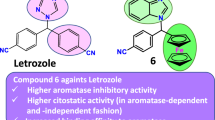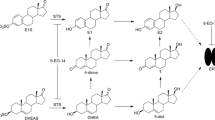Summary
Inhibition of aromatase has been an attractive approach for examining the roles of estrogen biosynthesis in various physiological or pathological processes. Effective aromatase inhibitors can serve as potential therapeutic agents for controlling estrogen-dependent diseases such as hormone-dependent breast cancer. Investigations on the development of aromatase inhibitors have therefore expanded greatly in the past two decades. Numerous steroidal agents have been developed that have high affinities for the aromatase enzyme complex and exhibit either competitive inhibition, irreversible inhibition, or mechanism-based (enzyme-activated) inhibition. Mechanism-based inhibitors have distinct advantages in drug design, since these inhibitors are highly enzyme specific, produce prolonged inhibition, and exhibit minimal toxicities.
Examination of the structure-activity relationships of the numerous steroidal aromatase inhibitors suggest that the spacial requirements for interaction of agents with the active site of aromatase are very restrictive, permitting only small structural changes to be made on the A-ring and at C-19. Incorporation of small polar substituents at the C-4 position, such as a hydroxyl group, or addition of aryl functionalities at the 7α-position of the steroid, are the exceptions, and inhibitors with such modifications exhibit enhanced affinity for the enzyme. Future investigations of steroidal aromatase inhibitors as probes of the active site of purified aromatase will provide valuable information on enzyme structure at the molecular level, will permit a more detailed examination of the mechanisms of inhibition, and will enhance the development of more specific and effective inhibitors for the treatment of estrogen-dependent breast cancer.
Similar content being viewed by others
References
Santen RJ, Santner S, Lipton A (eds): Aromatase: New perspectives for breast cancer. Cancer Res (suppl) 42:1s-3467s, 1982
Santen RJ (ed): Aromatase: Future perspectives. Steroids 50:1–665, 1987
Brodie AMH, Brodie HJ, Callard G, Robinson C, Roselli C, Santen RJ (eds): Basic and clinical aspects of aromatase. J Steroid Biochem Molec Biol 44:321–696, 1993
Corbin CJ, Graham-Lorence S, McPhaul M, Mason JI, Mendelson CR, Simpson ER: Isolation of a full-length cDNA insert encoding human aromatase system cytochrome P-450 and its expression in nonsteroidogenic cells. Proc Natl Acad Sci USA 85:8948–8953, 1988
Simpson ER, Mahendroo MS, Means GD, Kilgore MW, Corbin CJ, Mendelson CR: Tissue-specific promoters regulate aromatase cytochrome P450 expression. J Steroid Biochem Molec Biol 44: 321–330, 1993
Johnston JO, Metcalf BW: Aromatase: A target enzyme in breast cancer.In: Sunkara P (ed) Novel Approaches to Cancer Chemotherapy. Academic Press, New York, 1984, pp 307–328
Banting L, Smith HJ, James M, Jones G, Nazareth W, Nichols PJ, Hewlins MJE, Rowlands MG: Structureactivity relationships for non-steroidal inhibitors of aromatase. J Enzyme Inhibit 2:215–229, 1988
Covey DF: Aromatase inhibitors: specific inhibitors of oestrogen biosynthesis.In: Berg D, Plempel M (eds) Sterol Biosynthesis Inhibitors. Ellis Horwood, Chichester, UK, 1988, pp 534–571
Banting L, Nichols PJ, Shaw MA, Smith HJ: Recent development in aromatase inhibition as a potential treatment for oestrogen-dependent breast cancer. Prog Med Chem 26:253–298, 1989
Brueggemeier RW: Biochemical and molecular aspects of aromatase. J Enzyme Inhibit 4:101–111, 1990
Santen RJ, Manni A, Harvey H, Redmond C: Endocrine treatment of breast cancer in women. Endocrine Rev 11:221–265, 1990
Zeelen FJ: Medicinal Chemistry of Steroids. Elsevier, Amsterdam, 1990, pp 218–225
Blickenstaff RT: Antitumor Steroids. Academic Press, San Diego, 1992, pp 68–78
Schwarzel WC, Kruggel WG, Brodie HJ: Studies on the mechanism of estrogen biosynthesis. VII. The development of inhibitors of the enzyme system in human placenta. Endocrinol 92:866–880, 1973
Schubert K, Böhme KH, Hörhold C: Inhibition of estrogen biosynthesis using steroids. Endokrinol 64:19–21, 1974
Siiteri PK, Thompson EA: Studies on human placental aromatase. J Steroid Biochem 6:317–322, 1975
Brueggemeier RW, Floyd EE, Counsell RE: Synthesis and biochemical evaluation of inhibitors of estrogen biosynthesis. J Med Chem 21:1007–1011, 1978
Henderson D, Norbisrath G, Kerb U: 1-methy1-1,4-androstadiene-3,17-dione (SH489: characterization of an irreversible inhibitor of estrogen biosynthesis. J Steroid Biochem 24:303–306, 1986
Miyairi S, Fishman J: 2-methylene-substituted androgens as novel aromatization inhibitors. J Biol Chem 261:6772–6777, 1986
Brueggemeier RW, Katlic NE: Effects of the aromatase inhibitor 7α-(4′-amino)-thiopheny1-4-androstene-3,17-dione in human mammary carcinoma cell culture. Cancer Res 47:4548–4551, 1987
Brueggemeier RW, Li P-K, Snider CE, Darby MV, Katlic NE: 7α-substituted androstenediones as effectivein vitro andin vivo inhibitors of aromatase. Steroids 50:163–178, 1987
Brueggemeier RW, Li P-K: Effects of the aromatase inhibitor 7α-(4′-amino)-thiopheny1-4-androstene-3,17-dione on 7,12-dimethylbenz(a)anthracene-induced mammary carcinoma in rats. Cancer Res 48:6808–6810, 1988
Darby MV, Lovett JA, Brueggemeier RW, Groziak MP, Counsell RE: 7α-substituted derivatives of androstenedione as inhibitors of estrogen biosynthesis. J Med Chem 28:803–807, 1985
Li P-K, Brueggemeier RW: Synthesis and biochemical studies of 7-substituted 4,6-androstadiene-3,17-diones as aromatase inhibitors. J Med Chem 33:101–105, 1990
Li P-K, Brueggemeier RW: 7-substituted steroidal aromatase inhibitors: structure-activity relationships and molecular modeling. J Enzyme Inhibition 4:113–120, 1990
Kellis JT, Childers WE, Robinson CH, Vickery LE: Inhibition of aromatase cytochrome P-450 by 10-oxirane and 10-thiirane substituted androgens. J Biol Chem 262:4421–4426, 1987
Childers WE, Robinson CH: Novel 10β-thiiranyl steroids as aromatase inhibitors. J Chem Soc Chem Comm 320–321, 1987
Childers WE, Shih MJ, Furth PS, Robinson CH: Stereoselective inhibition of human placental aromatase. Steroids 50:121–134, 1987
Shih MJ, Carrell MH, Carrell HL, Wright CL, Johnston JO, Robinson CH: Stereoselective inhibition of aromatase by novel epoxysteroids. J Chem Soc Chem Comm 213–214, 1987
Deckers GH, Schuurs AHWM: Aromatase inhibition in hypophysectomised female rats: A novel animal model forin vivo screening. J Steroid Biochem 32:625–631, 1989
Wright JN, Calder MR, Akhtar M: Steroidal C-19 sulfur and nitrogen derivatives designed as aromatase inhibitors. J Chem Soc Chem Comm 1733–1735, 1985
Burkhart JP, Peet NP, Wright CL, Johnston JO: Novel time-dependent inhibitors of human placental aromatase. J Med Chem 34:1748–1750, 1991
Burkhart JP, Huber EW, Laskovics FM, Peet NP: Synthesis of 2,19-bridged androstenediones. J Org Chem 57:5150–5154, 1992
Peet NP, Burkhart JP, Wright CL, Johnston JO: Time-dependent inhibition of human placental aromatase with a 2,19-methyleneoxy bridged androstenedione. J Med Chem 35:3303–3306, 1992
Peet NP, Johnston JO, Burkhart JP, Wright CL: A-ring bridged steroids as potent inhibitors of aromatase. J Steroid Biochem Molec Biol 44:409–420, 1993
Johnston JO, Burkhart JP, Wright CL, Peet NP: Biological characterization of A-ring steroids. J Steroid Biochem Molec Biol 44:623–631, 1993
Snider CE, Brueggemeier RW: Covalent modification of aromatase by a radiolabeled irreversible inhibitor. J Steroid Biochem 22:325–330, 1985
Brueggemeier RW, Snider CE, Counsell RE: Substituted C19 analogs as inhibitors of estrogen biosynthesis. Cancer Res (suppl) 42:3334s-3337s, 1982
Bellino FL, Gilani SSH, Eng SS, Osawa Y, Duax WL: Active-site-directed inactivation of aromatase from human placental microsomes by brominated androgen derivatives. Biochemistry 15:4730–4736, 1976
Tan L, Petit A: Inactivation of human placental aromatase by 6α- and 6β-hydroperoxyandrostenedione. Biochem Biophys Res Commun 128:613–620, 1985
Silverman RB (ed): Mechanism-Based Enzyme Inhibition: Chemistry and Enzymology, Vol 1. CRC Press, Boca Raton, FL, 1988, pp 3–30
Covey DF, Hood WF, Parikh VD: 10β-propynyl-substituted steroids mechanism-based enzyme activated irreversible inhibitors of estrogen biosynthesis. J Biol Chem 256:1076–1079, 1981
Metcalf BW, Wright CL, Burkhart JP, Johnston JO: Substrate-induced inactivation of aromatase by allenic and acetylenic steroids. J Am Chem Soc 103:3221–3222, 1981
Marcotte PA, Robinson CH: Synthesis and evaluation of 10β-substituted estr-4-ene-3,17-diones as inhibitors of human placenta microsomal aromatase. Steroids 39:325–344, 1982
Johnston JO, Wright CL, Metcalf BW: Biochemical and endocrine properties of a mechanism-based inhibitor of aromatase. Endocrinol 115:776–785, 1984
Johnston JO, Wright CL, Metcalf BW: Time-dependent inhibition of aromatase in trophoblast tumor cells in tissue culture. J Steroid Biochem 20:1221–1226, 1984
Longcope C, Femino AM, Johnston JO: Inhibition of peripheral aromatization in baboons by an enzymeactivated aromatase inhibitor (MDL 18962). Endocrinol 122:2007–2011, 1988
Johnston JO: Biological characterization of 10-(2-propynyl)estr-4-ene-3,17-dione (MDL 18962), an enzyme-activated inhibitor of aromatase. Steroids 50:106–120, 1987
Ziminski SJ, Brandt ME, Covey DF, Puett D: Inhibition of aromatase activity and of endocrine-responsive tumor growth by 10-propargylestr-4-ene-3,17-dione and its 17-propionate derivative. Steroids 50:135–146, 1987
Marcotte PA, Robinson CH: Inhibition and inactivation of estrogen synthetase (aromatase) by fluorinated substrate analogs. Biochemistry 21:2773–2778, 1982
Bednarski PJ, Porubek DJ, Nelson SD: Thiol-containing androgens as suicide substrates of aromatase. J Med Chem 28:775–779, 1985
Bednarski PJ, Nelson SD: Interactions of thiol-containing androgens with human placental aromatase. J Med Chem 32:203–213, 1989
Marsh DA, Brodie HJ, Garrett W, Tsai-Morris C-H, Brodie AMH: Aromatase inhibitors. Synthesis and biological activity of androstenedione derivatives. J Med Chem 28:788–795, 1985
Brodie AMH, Garrett W, Hendrickson JR, Tsai-Morris C-H, Marcotte CH, Robinson CH: Inactivation of aromatase in vitro by 4-hydroxy-4-androstene-3,17-dione and 4-acetoxy-4-androstene-3,17-dione and sustained effects in vivo. Steroids 38:693–702, 1981
Brodie AMH, Schwarzel WC, Shaikh AA, Brodie HJ: The effect of an aromatase inhibitor 4-hydroxy-4-androstene-3,17-dione on estrogen dependent processes in reproduction and breast cancer. Endocrinol 100:1684–1695, 1977
Wing LY, Garrett W, Brodie AMH: Effects of aromatase inhibitors aminoglutethimide and 4-hydroxyandrostenedione on cyclic rats and rats with 7,12-dimethylbenz(a)anthracene-induced mammary tumors. Cancer Res 45:2425–2428, 1985
Brodie AMH, Garrett W, Hendrickson JR, Tsai-Morris C-H: Effects of aromatase inhibitor 4-hydroxyandrostenedione and other compounds in the 7,12-dimethylbenz(a)anthracene-induced breast carcinoma model. Cancer Res (suppl) 42:3360s-3364s, 1982
Coombes RC, Goss P, Dowsett M, Gazet JC, Brodie AMH: 4-hydroxyandrostenedione treatment of postmenopausal patients with advanced breast cancer. Lancet 2:1237–1239, 1984
Goss PE, Powles TJ, Dowsett M, Hutchison G, Brodie AMH, Gazet J-C, Coombes RC: Treatment of advanced postmenopausal breast cancer with an aromatase inhibitor 4-hydroxyandrostenedione: Phase II report. Cancer Res 46:4823–4826, 1986
Dowsett M, Cunningham D, Nichols S, Lal A, Evans S, Dehennin L, Hedley A, Coombes RC: Dose-related endocrine effects and pharmacokinetics of oral and intramuscular 4-hydroxyandrostenedione in postmenopausal breast cancer patients. Cancer Res 49: 1306–1312, 1989
Abul-Hajj YJ: Synthesis and evaluation of 4-(substituted thio)-4-androstene-3,17-dione derivatives as potential aromatase inhibitors. J Med Chem 29:582–584, 1986
di Salle E, Ornati G, Giudici D, Briatico G, Lombardi P: Irreversible aromatase inhibition by 4-aminoandrosta-4,6-diene-3,17-dione (FCE 24210). J Steroid Biochem 25:134S, 1986
Covey DF, Hood WF: Enzyme-generated intermediates derived from 4-androstene-3,6,17-trione and 1,4,6-androstatriene-3,17-dione cause a time-dependent decrease in human placental aromatase activity. Endocrinol 108:1597–1599, 1981
Covey DF, Hood WF: Aromatase enzyme catalysis is involved in the potent inhibition of estrogen biosynthesis caused by 4-acetoxy- and 4-hydroxy-4-androstene-3,17-diones. Mol Pharmacol 21:173–180, 1982
Snider CE, Brueggemeier RW: Potent enzyme-activated inhibition of aromatase by a 7α-substituted C19 steroid. J Biol Chem 262:8685–8689, 1987
Li P-K, Brueggemeier RW: Enzyme-mediated inactivation of aromatase by 7-substituted 1,4,6-androstatriene-3,17-diones. J Steroid Biochem 36:533–539, 1990
Brueggemeier RW, Katlic NE, Kenreigh CA, Li P-K: Aromatase inhibition by 7-substituted steroids in human choriocarcinoma cell culture. J Steroid Biochem Molec Biol 41:85–90, 1992
Ebrahimian S, Chen H-H, Brueggemeier RW: Synthesis and biochemical studies of 7α-substituted androsta-1,4-diene-3,17-diones as enzyme-activated inhibitors of aromatase. Steroids 58:414–422, 1993
Di Salle E, Giudici D, Ornati G, Briatico G, D'Alessio R, Villa V, Lombardi P: 4-aminoandrostenedione derivatives: A novel class of irreversible aromatase inhibitors. Comparison with FCE 24304 and 4-hydroxyandrostenedione. J Steroid Biochem 37:369–374, 1990
Giudici D, Ornati G, Briatico G, Buzzetti F, Lombardi P, Di Salle E: 6-methyleneandrosta-1,4-diene-3,17-dione (FCE 24304): A new irreversible aromatase inhibitor. J Steroid Biochem 30:391–394, 1988
Zaccheo T, Giudici D, Lombardi P, Di Salle E: A new irreversible aromatase inhibitor 6-methyleneandrosta-1,4-diene-3,17-dione (FCE 24304): Antitumor activity and endocrine effects in rats with DMBA-induced mammary tumors. Cancer Chemother Pharmacol 23:47–60, 1989
Zaccheo T, Giudici D, Di Salle E: Inhibitory effect of combined treatment with the aromatase inhibitor exemestane and tamoxifen on DMBA-induced mammary tumors in rats. J Steroid Biochem Molec Biol 44:677–680, 1993
Numazawa M, Tsuji M, Mutsumi A: Studies on aromatase inhibition with 4-androstene-3,6,17-trione: its 3β-reduction and time-dependent irreversible binding to aromatase with human placental microsomes. J Steroid Biochem 28:337–344, 1987
Numazawa M, Mutsumi A, Tsuji M: 3β-hydroxyandrost-4-en-6-one derivatives as aromatase inhibitors. Steroids 54:299–331, 1989
Brueggemeier RW, Moh PP, Ebrahimian S, Darby MV: Steroidal inhibitors as chemical probes of the active site of aromatase. J Steroid Biochem Molec Biol 44:357–365, 1993
Author information
Authors and Affiliations
Rights and permissions
About this article
Cite this article
Brueggemeier, R.W. Aromatase inhibitors — mechanisms of steroidal inhibitors. Breast Cancer Res Tr 30, 31–42 (1994). https://doi.org/10.1007/BF00682739
Issue Date:
DOI: https://doi.org/10.1007/BF00682739




